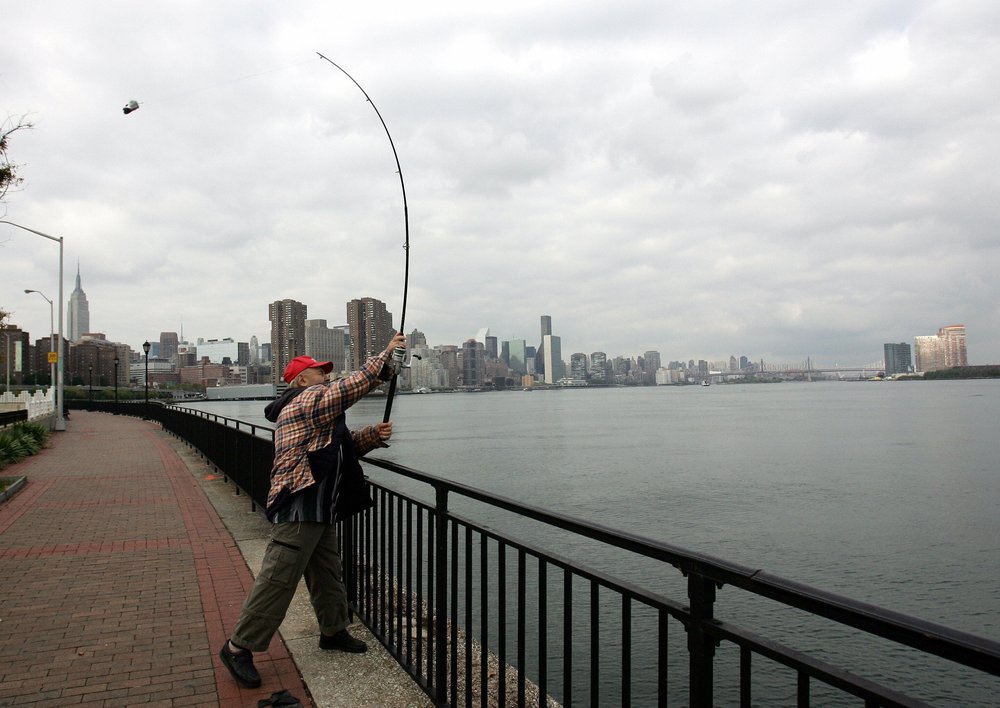Striped bass, a favorite of NYC anglers, sharply declining in Hudson River
Feb. 25, 2024, 11:01 a.m.
The 2023 count of juvenile striped bass is at its lowest level since the 1980s.

New York’s most beloved fish is spawning at an alarmingly low rate.
Striped bass is a prize catch in New York City and up the Hudson River. The fish is so popular along the East Coast it's even been called “America’s national fish,” though that designation isn’t official. But a new survey by the state Department Environmental Conservation showed the number of juvenile stripers in the Hudson River is at its lowest since 1985.
The drop mirrors a decadelong decline found in other major striper fisheries like the Chesapeake Bay and Delaware River, according to the Atlantic States Marine Fisheries Commission. New finalized regulations are set to go into effect this year in New York and along the Atlantic coast to help striped bass recover – but some advocates worry the measures don’t go far enough.
“We've seen a pretty steady decline in that spawning stock biomass, which is basically the amount of mature females that are able to reproduce in the population,” said Emilie Franke, the fishery management plan coordinator at Atlantic States Marine Fisheries Commission. The spawning stock from the Chesapeake Bay to Hudson River in 2010 was about 250 million pounds, according to Franke. About a decade later, it had dropped to 140 million pounds.
The Albany Times Union reported on the latest state count of juvenile striped bass earlier this month.
Sports fishers love stripers for their large size – the largest ever caught was 81 pounds – and how fun they are to catch. The fish swim from the Atlantic Ocean up the Hudson River to spawn each spring, giving anglers the chance to hook them from shore or off of a pier.
“It's the No. 1 fish that everyone goes after from Maryland to Rhode island,” said Adrian Moeller, who runs fishing trips for Rockfish Charters. “You can catch it from anywhere – pier, boat, beach – it's so accessible.”
The recent low tally contrasts with the experience of Moeller and other fishers. Last year was a terrific year for striper fishing.
“Fishing has never been better. We’ve never caught so many fish,” Moeller said.
But experts say last year’s low count is a lagging indicator that fishers won't notice for years. The recent bounty is the result of a boom spawning year in 2015. Fish born that year are now mature enough to be kept.
“Right now, there happens to be a lot of striped bass available in the fishery size limit,” Franke said. “The last few years of striped bass that have spawned have been very low. Although fishing is great right now, we anticipate there aren't that many strong year classes coming behind what we're seeing now.”
The Atlantic States Marine Fisheries Commission, which Congress recently formed to coordinate and manage fisheries, believes overfishing is the root cause, and sees tightening catch limits as the solution. The recreational harvest of stripers in 2022 was nearly double the previous year.

Last year, the commission put emergency restrictions on striped bass to reduce mortality rates. Those regulations will now be adopted as a final rule by May.
Recreational fishers south of the George Washington Bridge in New York are limited to taking home a single fish measuring between 28 and 31 inches. They were previously able to keep a catch measuring between 28 and 25 inches. Commercial harvest quotas will be reduced by 7%. The Hudson River and the waters surrounding New York City are currently closed to commercial striped bass fishing.
But some fishers oppose the new restrictions and question the data showing fewer juvenile striped bass.
Moeller said the new limits were imposed at the “last minute” and are “too restrictive.” He wondered if last year's decline was a result of striped bass spawning in new locations.
But other anglers support the restrictions. An Atlantic States Marine Fisheries Commission hearing last month showed that the vast majority of fishers – more than 2,000 anglers – wrote in favor of the new restrictions. The new effort is in line with a tradition dating back to at least the 1960s, when fishers successfully opposed plans for a hydroelectric plant along the Hudson River near Storm King Mountain, arguing it would harm the striped bass population.
George Jackman, the habitat restoration director with the environmental group Riverkeeper, agreed that overfishing is a big threat to striped bass. But he said the new regulations do not address fatalities from catch and release. Recent research by the fisheries commission found that nearly half of the striped bass killed in the Hudson River in 2017 died as a result of catch and release.
“When people catch and release stripers, you're only allowed to take one, but they continue to fish,” Jackman said. “It could harm the fish if the hook penetrates a vital organ; the fish could die.”
“We're actually very worried about these fish [striped bass]. These fish used to be Incredibly abundant, and they're not rebounding despite all the efforts we're taking to protect them,” Jackman added.
The Department of Environmental Conservation downplayed the significance of last year’s juvenile striped bass count, noting that it was a bad year for many other fish it monitors, including American shad, alewives and blueback herring.
“At this life stage, fish are very dependent on environmental conditions in the estuary. Less than ideal environmental conditions (too hot, too cold, too wet, too dry) will result in higher mortality, and lower overall abundance, of juvenile striped bass,” wrote DEC spokesperson Denis Slattery.
Using magnets, this fisherman is catching guns and bikes in NYC parks